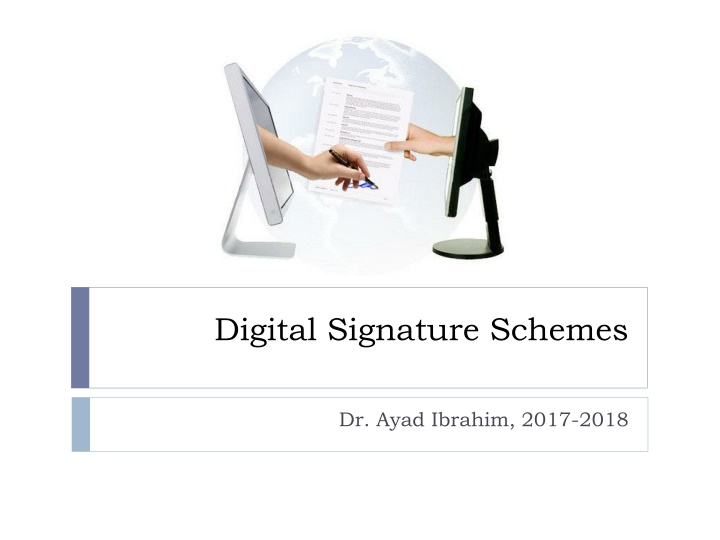
Digital Signature Schemes and RSA Signatures Overview
Dive into the world of digital signature schemes and RSA signatures with Dr. Ayad Ibrahim. Explore the advantages, adversary goals, attacks, and more in this comprehensive guide from 2017-2018.
Download Presentation

Please find below an Image/Link to download the presentation.
The content on the website is provided AS IS for your information and personal use only. It may not be sold, licensed, or shared on other websites without obtaining consent from the author. If you encounter any issues during the download, it is possible that the publisher has removed the file from their server.
You are allowed to download the files provided on this website for personal or commercial use, subject to the condition that they are used lawfully. All files are the property of their respective owners.
The content on the website is provided AS IS for your information and personal use only. It may not be sold, licensed, or shared on other websites without obtaining consent from the author.
E N D
Presentation Transcript
Digital Signature Schemes Dr. Ayad Ibrahim, 2017-2018
Outline Introduction Advantage of Digital signatures Adversary Goal RSA-signature Attacks on RSA-signature Hashed-RSA Shnorr Signature DSA algorithm
Introduction Digital signature schemes allow a signer S who has a public key pk to "sign" a message such that any other party who knows pk can verify the signature.
Services of digital signature Authentication: verify that the message originated from S. Integrity: ensure message has not been modified in any way. 1. 2. Signature schemes can be viewed as the public-key counterpart of message authentication codes.
Advantages of digital signature over MAC The sender sign message once for all recipients. Third party can verify the legitimate signature on m with respect to S's public key. Non-repudiation: a valid signature on a message is enough to convince the judge that S indeed signed this message. Message authentication codes have the advantage of being roughly 2-3 orders of magnitude more efficient than digital signatures.
Adversary Goal Existential forgery Given a public key pk generated by a signer S, we say an adversary outputs a forgery if it outputs a message m along with a valid signature on m, such that m was not previously signed by S
Attacks of RSA-signature The attack works as follows: given public key pk = <N, e>, choose arbitrary ? ? output the forgery (m, ). and compute ? = ????? ? ; then , sets m2 := The adversary can chooses a random m1 ? [m/m1 mod N], and then obtains signatures ?1,?2 on m1 and m2, respectively. We claim that := ?1.?2 mod N is a valid signature on m. This is because:
Hashed-RSA The basic idea is to take modify the textbook RSA signature scheme by applying some function H to the message before signing it.
Discrete Logarithm(s) (DLs) Fix a prime p. Let a, b be nonzero integers (mod p). The problem of finding x such that ax b (mod p) is called the discrete logarithm problem. Suppose that n is the smallest integer such that an 1 (mod p), i.e., n=ord(a). By assuming 0 x<n, we denote x=La(b), and call it the discrete log of b w.r.t. a (mod p) Ex: p=11, a=2, b=9, then x=L2(9)=6
Schnorrs Signature Schnorr assumes the discrete log problem is difficult in prime order groups. Key generation
Schnorrs Signature Signing A user with private key and public key generates a signature as follows.
Schnorrs Signature Verification
Digital Signature Algorithm (DSA) creates a 320 bit signature with 512-1024 bit security smaller and faster than RSA a digital signature scheme only security depends on difficulty of computing discrete logarithms
DSA Key Generation have shared global public key values (p, q, g): choose 160-bit prime number q choose a large prime p with 2L-1< p < 2L where L= 512 to 1024 bits and is a multiple of 64 such that q is a 160-bit prime divisor of (p-1) choose g = h(p-1)/q where 1<h<p-1 and h(p-1)/q mod p > 1 users choose private & compute public key: choose random private key: x<q compute public key: y = gxmod p
DSA Signature Creation to sign a message M the sender: generates a random signature key k, k<q nb.k must be random, be destroyed after use, and never be reused then computes signature pair: r = (gkmod p)mod q s = [k-1(H(M)+ xr)] mod q sends signature (r,s) with message M
DSA Signature Verification having received M & signature (r,s) to verify a signature, recipient computes: w = s-1 mod q u1= [H(M)w ]mod q u2= (rw)mod q v = [(gu1yu2)mod p ]mod q if v=r then signature is verified
